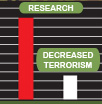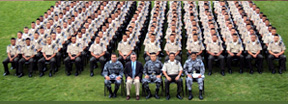This article was published on 26 November 2008 by South Asian Media Net. [Expired URL:
http://www.southasianmedia.net/index_opinion.cfm?category=Politics&country=bangladesh#A Proven Approach to Make Bangladesh Strong and Invincible]
A Proven Approach to Make Bangladesh Strong and Invincible
Ex-premier and Awami League President Sheikh Hasina believes in building a “strong and invincible” defense system for protecting Bangladesh’s independence and sovereignty. (“Armed Forces Day Today,” The Daily Star, November 21, 2008). This goal is noble. Bangladesh should strive to become invincible. However, ultimately the only way to become truly invincible is not to have any enemies. If there are no internal or external threats, there are no enemies. No enemies, no conflict.
But how could such an ideal goal be achieved in Bangladesh where tensions are often high? A proven scientifically validated approach is needed to reduce tensions.
Despite its advanced technology and valiant efforts, the Bangladesh armed forces struggle to eliminate violent extremism. Violent extremism is a human problem requiring human solutions. The underlying cause of extremist social violence is accumulated social stress. Therefore, to eliminate such social problems, the Bangladesh armed forces need to reduce the collective societal stress in Bangladesh.
Extensive scientific research indicates that the best way to reduce collective societal stress, eliminate extremism and thereby snuff out war and terrorism, is to adopt an ancient strategy. Maharishi Mahesh Yogi has revived the ancient Vedic technology of Invincible Defence Technology (IDT) in a non-religious manner. It has been quietly and successfully used by members of many faiths to eliminate conflict in the past.
A Prevention Wing of the Military consisting of less than 3% of the military of Bangladesh could achieve this goal. This special unit would be trained in the Transcendental Meditation (TM) and TM-Sidhi programs. The unit would practice these techniques in large groups, twice a day.
Extensive research shows that the size of the group needed to reduce social stress depends on population size. It needs to be at least the square root of 1% of the population. To calculate this number, multiply the population size by 0.01, and then take the square root of the result. For instance, the population of Bangladesh is approximately 146 million. 146,600,000 x 0.01 =1,466,000. The square root of 146,600,000 is approximately 1,211, so a group of at least 1,211 IDT experts is needed. Studies show that when the threshold is crossed, the “Maharishi Effect” takes place.
Crime goes down, quality of life indices go up, and war and terrorism abate. For instance, a Maharishi Effect intervention was studied in the US capital in 1993. Predictions were lodged in advance with government leaders and newspapers. An independent Project Review Board approved the research protocol. Crime fell 23 percent below the predicted level when the group size reached its maximum. Temperature, weekend effects, and previous trends in the data failed to account for changes. Social Indicators Research (1999, vol. 47, 153-201) published the results.
Over 50 studies have shown that IDT works. The causal mechanism for IDT is not completely understood. However, a Journal of Social Behavior and Personality (2005, vol. 17, #1, pp. 339-373) study offers a proposed explanation of causality of IDT in biological terms. Research conducted on the powerful neurotransmitter serotonin shows that it produces feelings of contentment, happiness and even euphoria. Low levels of serotonin, according to research, correlate with violence, aggression, and poor emotional moods. The IDT study showed that higher numbers of IDT experts correlated with other community members having a marked increase in serotonin production. These results were statistically significant and followed the attendance figures. This offers a plausible neurophysiologic mechanism to explain reduced hostility and aggression in society at large.
The Maharishi Effect has also been documented world-wide in a study published in the Journal of Offender Rehabilitation (2003, vol. 36., #1-4, 283-302) using data provided by the Rand Corporation. When large assemblies of IDT experts exceeded the Maharishi Effect threshold for the world during the years 1983-1985, terrorism decreased globally 72%, international conflict decreased 33%, and violence was reduced in other nations without intrusion by other governments.
The military in Mozambique used IDT to end its civil war in the 1990s. Today, The Netherlands, Bolivia, Colombia, Trinidad and Tobago, and Peru have enough practitioners of the TM-Sidhi program to create the Maharishi Effect. The United States of America is close to achieving the requisite number of IDT experts through the Invincible America Assembly in Fairfield, Iowa. And India is working on a global project. These are all civilian groups. The pilot project in Mozambique dissolved after the United Nations broke up the military as part of the civil war treaty. High school students, who will graduate and move on, make up the bulk of the practitioners in Colombia. Limited economic opportunities in Iowa have hindered the development of the group in the USA. Long-term civilian groups may not be reliable.
The armed forces of Bangladesh are responsible for protecting Bangladesh, and are obligated to thoroughly examine realistic, scientifically proven methods for ending war and terrorism.
Since the Bangladesh military is funded and its personnel are paid to perform their duties, it is not subject to the fluctuations of donors, jobs, graduations, and optional activities. Military members are paid to protect the nation. Ultimately, it is the duty of the Bangladesh military to build a Prevention Wing of the Military and make Bangladesh truly invincible.
About the author:
Dr. David Leffler, an eight-year United States Air Force veteran, is now the Executive Director at the Center for Advanced Military Science (CAMS) at the Institute of Science, Technology and Public Policy www.StrongMilitary.org, an organization in the United States that advocates prevention-oriented technologies for the military.








